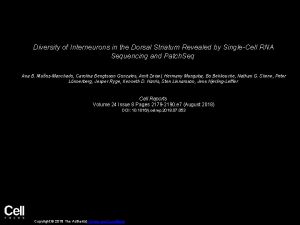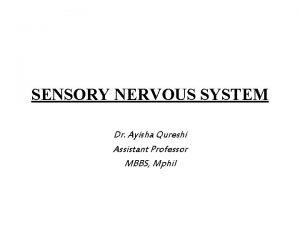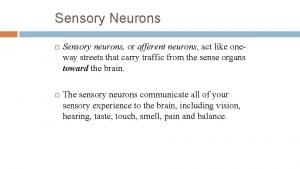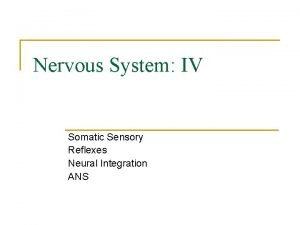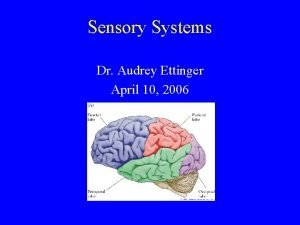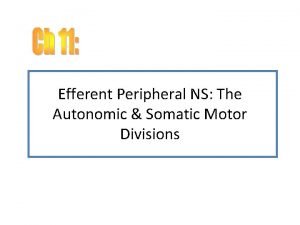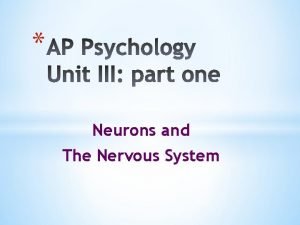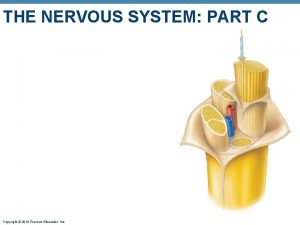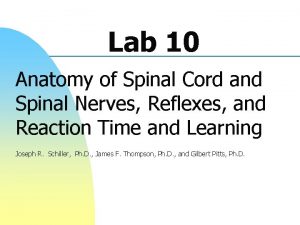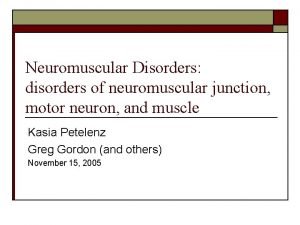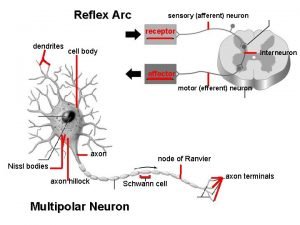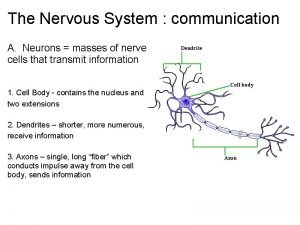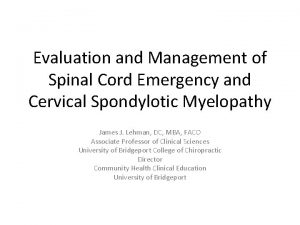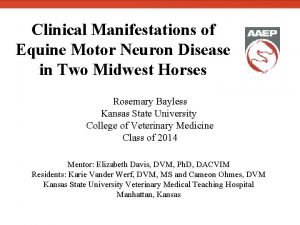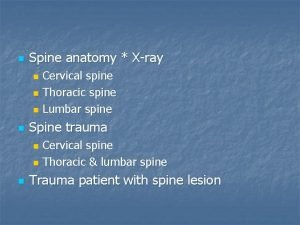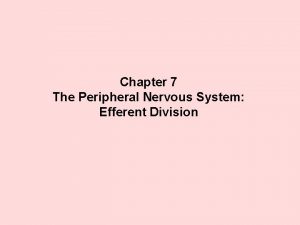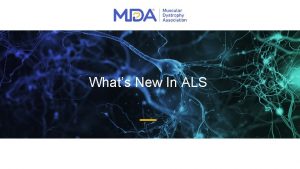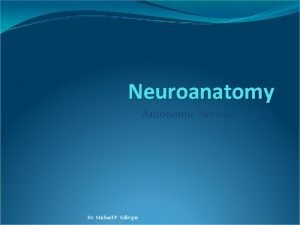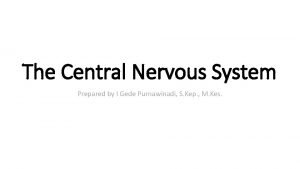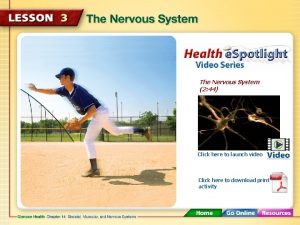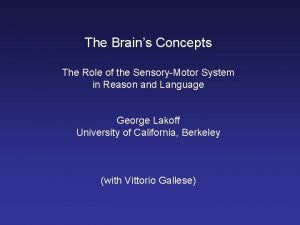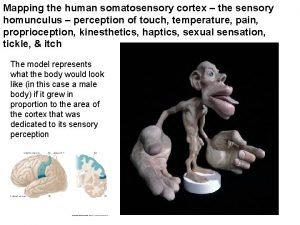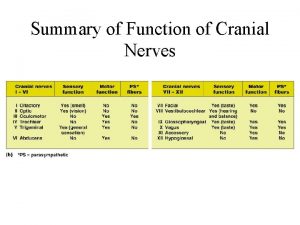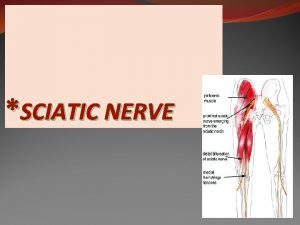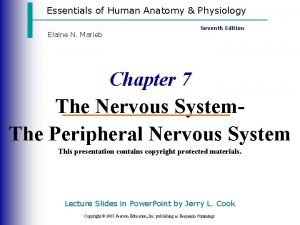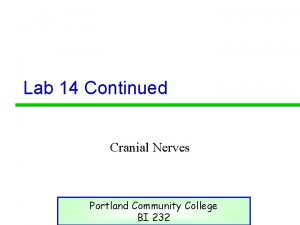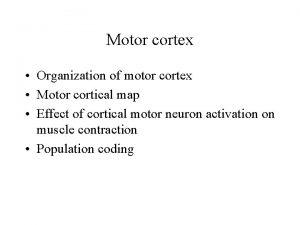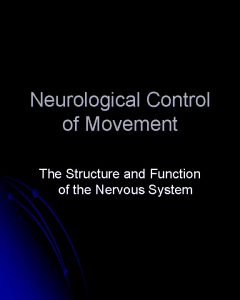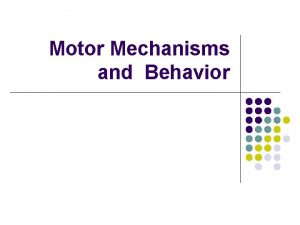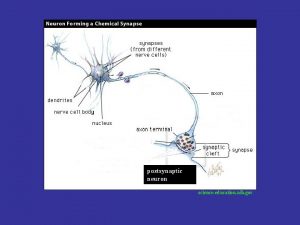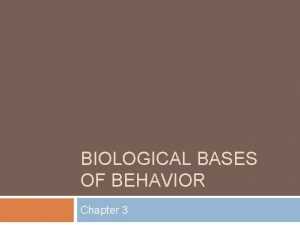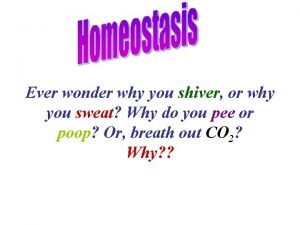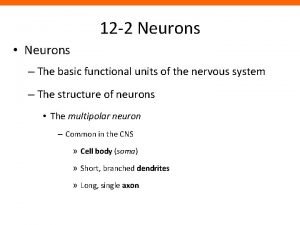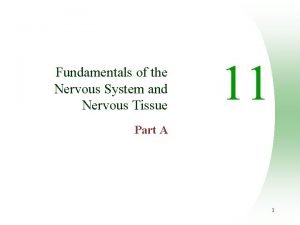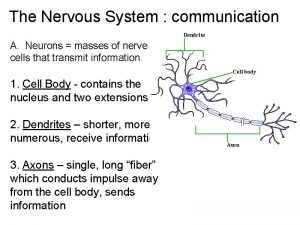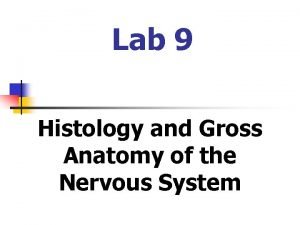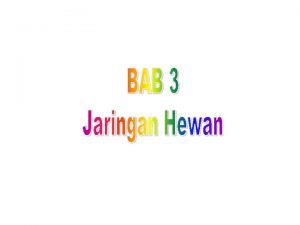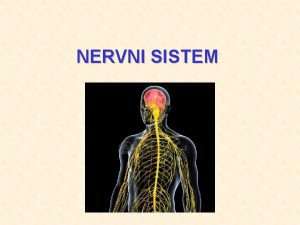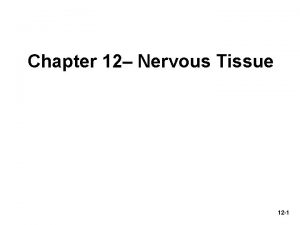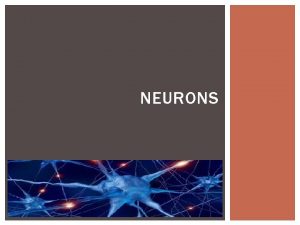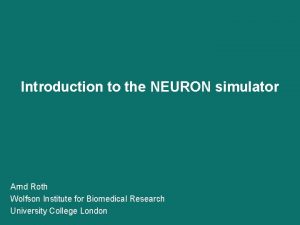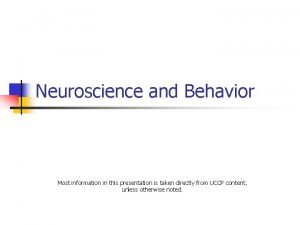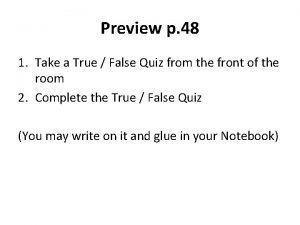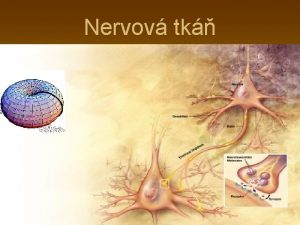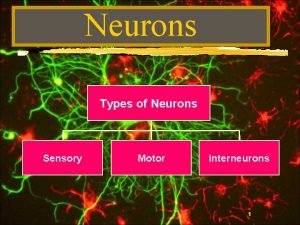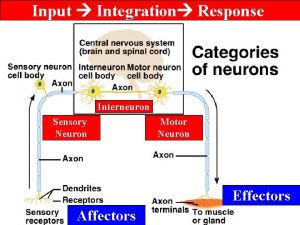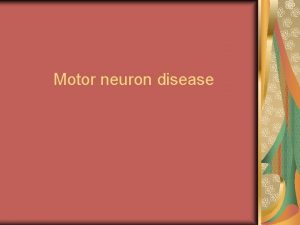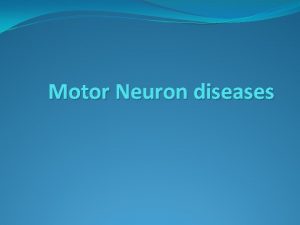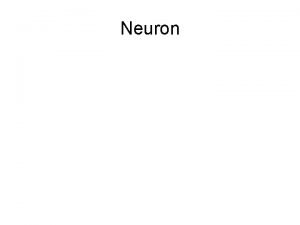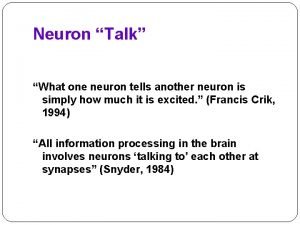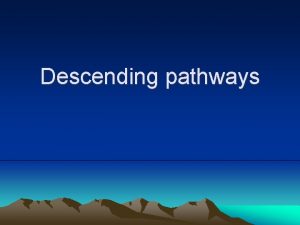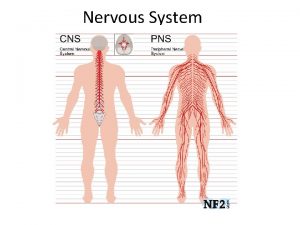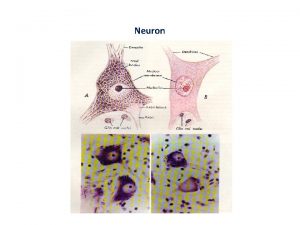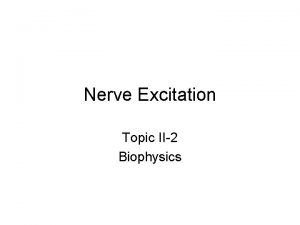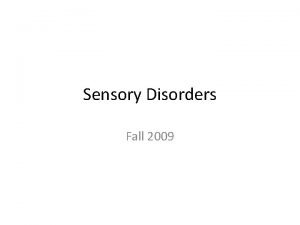Neurons Neuron Sensory neurons Motor neurons Interneurons A








































































- Slides: 72

Neurons • Neuron – Sensory neurons – Motor neurons – Interneurons

A Simple Reflex

A Simple Reflex

A Simple Reflex

Neurons • Parts of a Neuron – Dendrite – Axon – Myelin sheath • Multiple sclerosis – Terminal branches – Cell body

Neurons

Neurons

• • • Soma = Purple Dendrites = Blue Axon = Red Nodes of Ranvier = (still red) Myelin Sheath = Yellow Axon/Terminal Buttons = green Color & Label


• http: //www. youtube. com/watch? v=p 5 z. Fg. T 4 a of. A

How Neurons Communicate • • Synapse Synaptic gap (synaptic cleft) Neurotransmitters Reuptake


How Neurons Communicate

Action Potential Explained: http: //www. youtube. com/watch? v=Hn. KMB 11 ih 2 o

Action Potential


Action Potential a) Resting membrane potential (RMP) at -70 m. V. Na+ on outside and K+ on inside of cell b) As depolarization reaches threshold of -55 m. V, the action potential is triggered and Na+ rushes into cell. Membrane potential reaches +30 m. V on action potential c) Propagation of the action potential at 100 m/sec (which is 225 mph). Membrane potential at +30 m. V d) Repolarization occurs with K+ exiting the cell to return to -70 m. V RMP e) Return of ions (Na+ and K+) to their extracellular and intracellular sites by the sodium potassium (Na+K+) pump

Neurons • Firing of a neuron – Depolarize – Refractory period – Excitatory versus inhibitory – Threshold – All or none response

Action Potential


Neuron Communication • There are three matching puzzles and two cube puzzles. • With a partner, rotate around the stations. Try and complete each one. Check your answers before moving on. • When you are done – SCRAMBLE the puzzle for the next group. • If you are waiting for a puzzle, practice with bio flashcards

How Neurotransmitters Influence Us • • Acetylcholine (Ac. H) Dopamine Serotonin Norepinephrine GABA Glutamate Endorphins


How Neurotransmitters Influence Us How Drugs and Other Chemicals Alter Neurotransmitters • Agonists versus antagonists – Agonists – antagonists

Agonists and Antagonists

Neurotransmitter Game • Organize & count the chips • Factor in Agonists & Antagonists • Determine the impact! • Ex: 4 E (Blue) -1 E (Yellow), 1 A (Pink), 5 D (Lt Green) +2 D (Yellow) Chips Effects

3 C Answers 1. A 2. A 3. B 4. C 5. E 6. D 7. B 8. B 9. A 10. C 11. E 12. D 13. A 14. C 15. D FRQ: Fraternal vs. Identical twins, twin studies

The Nervous System

The Nervous System

Introduction • Nervous System – Central Nervous System (CNS) – Peripheral Nervous System (PNS) • Nerves

The Peripheral Nervous System • Somatic Nervous System • Autonomic Nervous System – Sympathetic nervous system – Parasympathetic nervous system


The Central Nervous System • Brain and spinal cord • Neural networks • Spinal cord – Reflex

The Endocrine System

Endocrine System • Endocrine system – Hormones – Adrenal glands • Epinephrine and norepinephrine • Adrenaline and noradrenaline • Fight or flight response – Pituitary gland



The End

• Types of Files Teacher Information – This presentation has been saved as a “basic” Powerpoint file. While this file format placed a few limitations on the presentation, it insured the file would be compatible with the many versions of Powerpoint teachers use. To add functionality to the presentation, teachers may want to save the file for their specific version of Powerpoint. • Animation – Once again, to insure compatibility with all versions of Powerpoint, none of the slides are animated. To increase student interest, it is suggested teachers animate the slides wherever possible. • Adding slides to this presentation – Teachers are encouraged to adapt this presentation to their personal teaching style. To help keep a sense of continuity, blank slides which can be copied and pasted to a specific location in the presentation follow this “Teacher Information” section.

Teacher Information • Hyperlink Slides - This presentation contain two types of hyperlinks. Hyperlinks can be identified by the text being underlined and a different color (usually purple). – Unit subsections hyperlinks: Immediately after the unit title slide, a page (slide #3) can be found listing all of the unit’s subsections. While in slide show mode, clicking on any of these hyperlinks will take the user directly to the beginning of that subsection. This allows teachers quick access to each subsection. – Bold print term hyperlinks: Every bold print term from the unit is included in this presentation as a hyperlink. While in slide show mode, clicking on any of the hyperlinks will take the user to a slide containing the formal definition of the term. Clicking on the “arrow” in the bottom left corner of the definition slide will take the user back to the original point in the presentation. These hyperlinks were included for teachers who want students to see or copy down the exact definition as stated in the text. Most teachers prefer the definitions not be included to prevent students from only “copying down what is on the screen” and not actively listening to the presentation. For teachers who continually use the Bold Print Term Hyperlinks option, please contact the author using the email address on the next slide to learn a technique to expedite the returning to the original point in the presentation.

Teacher Information • Continuity slides – Throughout this presentation there are slides, usually of graphics or tables, that build on one another. These are included for three purposes. • By presenting information in small chunks, students will find it easier to process and remember the concepts. • By continually changing slides, students will stay interested in the presentation. • To facilitate class discussion and critical thinking. Students should be encouraged to think about “what might come next” in the series of slides. • Please feel free to contact me at kkorek@germantown. k 12. wi. us with any questions, concerns, suggestions, etc. regarding these presentations. Kent Korek Germantown High School Germantown, WI 53022 262 -253 -3400 kkorek@germantown. k 12. wi. us

Division title (green print) subdivision title (blue print) • xxx – xxx

Division title (green print) subdivision title (blue print) Use this slide to add a table, chart, clip art, picture, diagram, or video clip. Delete this box when finished

Definition Slide = add definition here

Definition Slides

Biological Psychology = a branch of psychology concerned with the links between biology and behavior. • Some biological psychologists call themselves – behavioral neuroscientists, – neuropsychologists, – behavior geneticists, – physiological psychologists, or – biopsychologists.

Neuron = a nerve cell; the basic building block of the nervous system.

Sensory Neurons = neurons that carry incoming information from the sensory receptors to the brain and spinal cord.

Motor Neurons = neurons that carry outgoing information from the brain and spinal cord to the muscles and glands.

Interneurons = neurons within the brain and spinal cord that communicate internally and intervene between the sensory inputs and motor outputs.

Dendrite = the bushy, branching extensions of a neuron that receive messages and conduct impulses toward the cell body.

Axon = the extension of a neuron, ending in branching terminal fibers, through which messages pass to other neurons or to muscles or glands.

Myelin Sheath = a layer of fatty tissue segmentally encasing the fibers of many neurons; enables vastly greater transmission speed of neural impulses as the impulse hops from one node to the next.

Action Potential = a neural impulse; a brief electrical charge that travels down an axon.

Threshold = a level of stimulation required to trigger a neural impulse.

Synapse = the junction between the axon tip of the sending neuron and the dendrite or cell body of the receiving neuron. The tiny gap at this junction is called the synaptic gap or synaptic cleft.

Neurotransmitters = chemical messengers that cross the synaptic gaps between neurons. When released by the sending neuron, neurotransmitters travel across the synapse and bind to receptor sites on the receiving neuron, thereby influencing whether that neuron will generate a neural impulse.

Reuptake = a neurotransmitter’s reabsorption by the sending neuron.

Endorphins = “morphine within” – natural, opiatelike neurotransmitters linked to pain control and pleasure.

Nervous System = the body’s speedy, electrochemical communication network, consisting of all the nerve cells of the peripheral and central nervous systems.

Central Nervous System = the brain and spinal cord.

Peripheral Nervous System = the sensory and motor neurons that connect the central nervous system (CNS) to the rest of the body.

Nerves = bundled axons that form neural “cables” connecting the central nervous system with muscles, glands, and sense organs.

Somatic Nervous System = the division of the peripheral nervous system that controls the body’s skeletal muscles. • Also called the skeletal nervous system.

Autonomic Nervous System = the part of the peripheral nervous system that controls the glands and the muscles of the internal organs (such as the heart). Its sympathetic division arouses; its parasympathetic division calms.

Sympathetic Nervous System = the division of the autonomic nervous system that arouses the body, mobilizing its energy in stressful situations.

Parasympathetic Nervous System = the division of the autonomic nervous system that calms the body, conserving its energy.

Reflex = a simple, autonomic response to a sensory stimulus such as the knee-jerk response.

Endocrine System = the body’s “slow” chemical communication system; a set of glands that secrete hormones into the bloodstream.

Hormones = chemical messengers that are manufactured by the endocrine glands, travel through the bloodstream, and affect other tissues.

Adrenal Glands = a pair of endocrine glands that sit just above the kidneys and secrete hormones (epinephrine and norepinephrine) that help arouse the body in times of stress.

Pituitary Gland = the endocrine system’s most influential gland. Under the influence of the hypothalamus, the pituitary regulates growth and controls other endocrine glands.
 What is a motor unit
What is a motor unit Cholinergic interneurons striatum
Cholinergic interneurons striatum Reflex action
Reflex action Receptive fields of sensory neurons
Receptive fields of sensory neurons Diagram of the sensory neuron
Diagram of the sensory neuron Sensory modality examples
Sensory modality examples Location of sensory neurons
Location of sensory neurons Audrey ettinger
Audrey ettinger Preganglionic parasympathetic fibres
Preganglionic parasympathetic fibres Somatic nervous system
Somatic nervous system Lower motor neuron
Lower motor neuron Paraplrgia
Paraplrgia Motor neuron adalah
Motor neuron adalah Somatic motor pathway
Somatic motor pathway Site of somatic motor neuron cell bodies
Site of somatic motor neuron cell bodies Postasthmatic
Postasthmatic Somatic motor neuron
Somatic motor neuron Motor neuron
Motor neuron Somatic vs autonomic nervous system
Somatic vs autonomic nervous system Site of somatic motor neuron cell bodies
Site of somatic motor neuron cell bodies Motor neuron adalah
Motor neuron adalah Upper motor neuron
Upper motor neuron Equine motor neuron disease
Equine motor neuron disease Nipple line t4
Nipple line t4 Umnl and lmnl
Umnl and lmnl Lower motor neuron
Lower motor neuron Clasp knife reflex
Clasp knife reflex Efferent motor neurons
Efferent motor neurons Upper motor neurons
Upper motor neurons Autonomic motor neurons regulate visceral activities by
Autonomic motor neurons regulate visceral activities by Motor and sensory nerve
Motor and sensory nerve Sensory input and motor output
Sensory input and motor output Classification of nervous system
Classification of nervous system Cranial nerves sensory and motor
Cranial nerves sensory and motor Cranial nerve
Cranial nerve Incoming sensory impulses and outgoing motor impulses
Incoming sensory impulses and outgoing motor impulses Sensory cranial nerves
Sensory cranial nerves Sensory-motor
Sensory-motor Axon
Axon Homunculus somatosensory map
Homunculus somatosensory map Pterion
Pterion Sensory cranial nerves
Sensory cranial nerves Branches of sciatic nerve
Branches of sciatic nerve Cranial nerve mnemonics
Cranial nerve mnemonics Cranial nerve
Cranial nerve Motor cortex sensory cortex
Motor cortex sensory cortex Saltitory
Saltitory Tissue
Tissue Motor parts name
Motor parts name Ee 216
Ee 216 Pony motor starting method
Pony motor starting method Pony motor starting synchronous motor
Pony motor starting synchronous motor Postsynaptic neuron
Postsynaptic neuron A neuron without terminal buttons would be unable to
A neuron without terminal buttons would be unable to Mirror neuron
Mirror neuron Neuron anatomy
Neuron anatomy Anaxonic neuron definition
Anaxonic neuron definition Neuron n
Neuron n Chapter 7 the nervous system
Chapter 7 the nervous system Relative refractory period
Relative refractory period Convergence neuron
Convergence neuron Neuron
Neuron Vermis sheep brain
Vermis sheep brain Jaringan
Jaringan Nervno misicna sinapsa
Nervno misicna sinapsa Cns histology ppt
Cns histology ppt Figure 12-1 the neuron
Figure 12-1 the neuron All or none principle of action potential
All or none principle of action potential Arnd roth
Arnd roth Parts of a neuron
Parts of a neuron Graded vs action potential
Graded vs action potential Neuron
Neuron Astrocyte
Astrocyte

